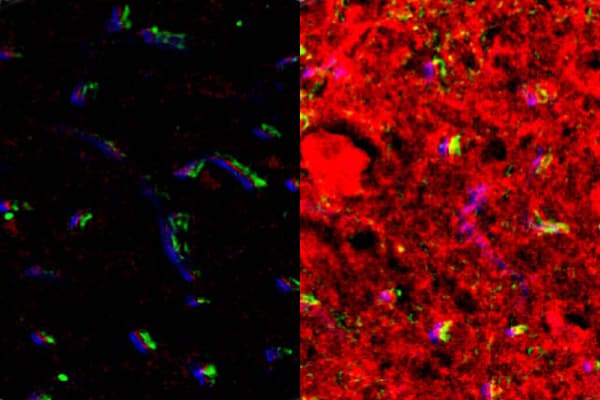Focused-ultrasound intranasal delivery promising in therapeutic agent delivery to brain tumor
Dezhuang Ye in Hong Chen’s lab tests novel method in brain tumor model

Brainstem glioma is often diagnosed in children and young adults and has a low survival rate. A multidisciplinary team at Washington University in St. Louis developed a technique that delivered a therapeutic agent to the gliomas using focused ultrasound with very promising results.
Dezhuang Ye, a doctoral student in the lab of Hong Chen, assistant professor of biomedical engineering in the McKelvey School of Engineering and of radiation oncology at the School of Medicine, has been working to develop the focused ultrasound-mediated intranasal brain drug delivery (FUSIN). Ye, who recently defended her doctoral thesis, delivered an immune checkpoint inhibitor to the brainstem gliomas in a mouse model using FUSIN, which resulted in drug accumulation within the brainstem. They found that FUSIN boosted the accumulation of the immune checkpoint inhibitor at its target by an average of four times more compared with intranasal delivery alone. Results were published in Pharmaceutics Feb. 1, 2021.
Diffuse intrinsic pontine glioma (DIPG) is the most common and deadliest childhood brainstem glioma with nearly 100% fatality and a median survival of less than 1 year from diagnosis. Surgery is not an option for the treatment of DIPG because the brainstem controls basic life functions such as breathing. Radiation treatment can only help alleviate symptoms but does not offer a cure. Chemotherapy is mostly ineffective due to the often-intact blood-brain barrier (BBB), which presents an obstacle for most drugs to reach the brain.
This is where the FUSIN method differs. FUSIN uses the nasal route for direct nose-to-brain drug administration, bypassing the BBB, avoiding first-pass metabolism and minimizing systemic exposure. It also uses ultrasonic energy to target tumors deep in the brainstem. Microbubbles are injected into the blood and oscillate once they reach the ultrasound-targeted tissue. This bubble oscillation generates mechanical forces that enhance the transportation and accumulation of intranasally administered drugs at the brainstem.
“Our findings suggest that FUSIN is a promising technique to facilitate the delivery of immune checkpoint inhibitors to the brain,” Ye said. “We are encouraged by these results and will continue to investigate its mechanism and application.”
Ye D, Yuan J, Yue Y, Rubin J, Chen H. Focused Ultrasound-Enhanced Delivery of Intranasally Administered Anti-Programmed Cell Death-Ligand 1 Antibody to an Intracranial Murine Glioma Model. Pharmaceutics. Published online Feb. 1, 2021. https://doi.org/10.3390/pharmaceutics13020190.
Funding for this research was provided by the National Institutes of Health (R01EB027223, R01EB030102, R01MH116981); the Charlie Teo Foundation and the Little Legs Foundation.





